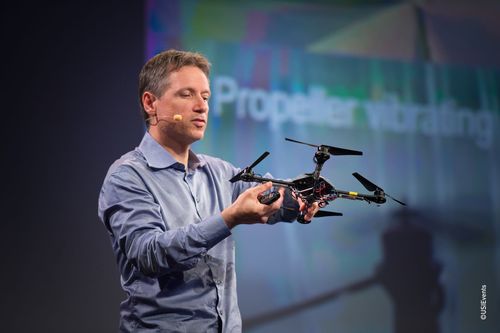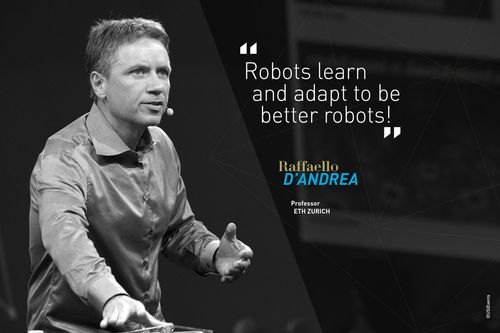Raffaello d'Andrea - Catching interconnected robots on the wing
The transformation in robots since the end of the 1990s is astounding: terrestrial robots, after several years of research, were able to implement team dynamics perfectly and play an entire football match without any outside intervention. In the age of the Internet of Things and given the issues around the use of drones, such capacities raise numerous questions.
Raffaello D'Andrea cofounded the company Kiva Systems which offers robots capable of interacting with their physical environment, able to carry out complex inventory tasks using distributed intelligence: each robot carries out its task, loads and delivers products. The company was acquired by Amazon in 2012, and the robots are now used in their warehouses.
Robots capable of improvement
According to Raffaello D'Andrea, what made his company successful was not only the right technologies, but especially an approach based on the key point that robots are capable of learning and adapting to become better robots.
With this principle in mind, he returned in 2008 to his early passions: flying machines, that he has play with each other. The surprising behavior of these quadcopters relies on an algorithm which constantly orders the robots to determine the best way to return the ball in three milliseconds. "Algorithms can make robots do things that humans are incapable of" explains Raffaello D’Andrea.
Like humans, robots learn from their mistakes
In his view, the future of drones lies in adaptation and learning: drones learn, and once they have integrated the learning, learning can be transmitted ever faster, leading to savings since less costly robots can learn to act like a more expensive robot.
Robots start over until they have succeeded in their allotted mission, the way children do. Seeing a cubic robot fall over and get up again until it is able to find its balance on a narrow ledge can be very moving. "We expect machines to be immediately effective, but how do you make a robot viable if it takes it two years to learn? " queries this expert in robotics. For him, the answer lies in sharing information: drones must be capable of transmitting what they have learned.
Magic or technology?
In this way, the project RoboEarth to create a cloud for robots was initiated in 2008 and has raised numerous issues. Terminator constantly returned like a leitmotiv in the ears of Raffaello D'Andrea, but he wasn't impressed. "People have an apocalyptic vision of connected robots, but I'm not worried" he affirms.
"All sufficiently advanced technology is indiscernible from magic", to quote Arthur C. Clarke. However, to avoid its transformation into black magic, you have to be in the race: if we are capable of using drones in a positive way, they will not be taken off the market, however if they should fall in the wrong hands, work in the area could be squashed in the bud, at least for several years. "The faster we get them out, the better it will be" he urges.
You might also like:
-Smart cities : from "digital cities" to "living cities", Carlos Moreno
-Data in the service of innovation, Hilary Mason

